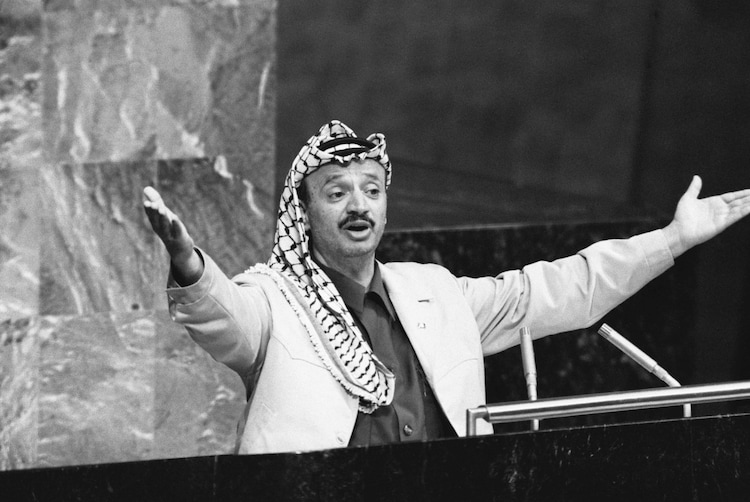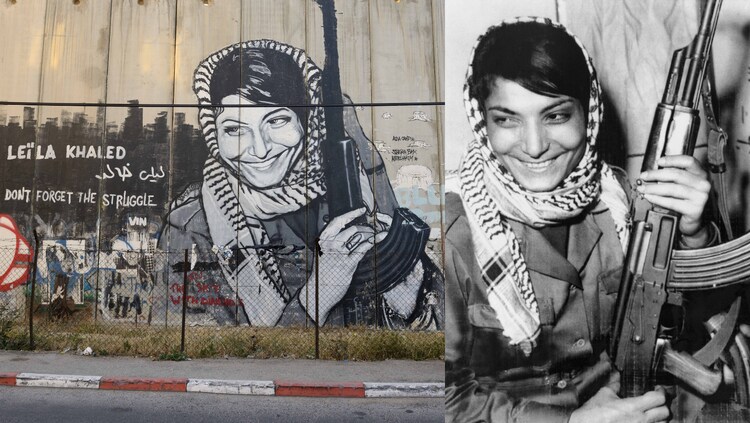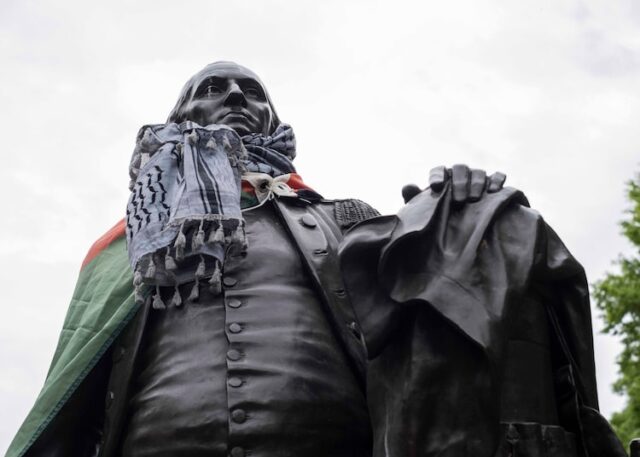
When the water sprinklers on the lawns of the Arizona State University in Phoenix were suddenly turned on, protesters occupying the lawns for weeks, chanted slogans accompanied by drumbeats from a plastic bucket. Just one look was enough to tell that the students were pro-Palestinian protesters, because they sported the keffiyeh.
Keffiyeh, the Beduin headscarf that originated around the 7th Century in the Levant region (now Iraq), has seen character transformations. From being worn as protective headgear by shepherds to identity-concealing masks by terrorists in the 80s; from a fashion accessory of the 90s to a mark of the recent pro-Palestinian anger across the world.
The clip of the students at Arizona State University is among the thousands of videos of campus protests and police-students face-off flooding the internet. In the videos, three pieces of cloth used by the pro-Palestinian protestors stand out.
The Palestinian flag, face masks and the keffiyeh.
While the medical masks are used to hide their identities, the distinct black and white chequered scarf, the keffiyeh, is used to reveal their cause.
KEFFIYEH A CONSTANT IN PROTESTS ACROSS CONTINENTS
The minimal yet prominent keffiyeh hasn’t just seen patronage on US campuses, thousands have worn the iconic drape at pro-Palestine protests across English, French, Italian, Australian cities and some West Asian cities.
The pro-Palestine protesters even draped a statue of the first American president, George Washington, with a Palestinian flag and wrapped a black-and-white keffiyeh around its neck, on the George Washington University campus.
A similar visual emerged from the University of Pennsylvania in Philadelphia too.
The pro-Palestinian campus protests, calling for a ceasefire in the ongoing war in Gaza and demanding the US to stop supporting Israel’s attacks in the Palestinian territories, started in American universities and have spread to other continents.
However, the keffiyeh is a constant even across continents. So, what’s this piece of cloth, uniting pro-Palestine protests, world over?
WHAT IS THE PALESTINIAN SYMBOL, KEFFIYEH?
Keffiyeh, also known as a hatta, is a traditional Arab drape, mostly used as a headgear or a scarf. Although other communities in the region also put scarves on their heads, the black-and-white chequered keffiyeh is the one from Palestine. It has a distinct design.
Traditionally worn by the Arab nomadic Bedouins during Ottoman rule, the humble cloth made from cotton, with distinct woven patterns in black and white, became a symbol of Palestinian nationalism during the Arab Revolt of 1936–1939 against the Ottomans.

Initially worn by Palestinian village folk, to signify their rural identity against the urban tarboosh (truncated cone-shaped men’s cap), keffiyeh evolved into a powerful symbol of Palestinian nationalism and its resistance against the Turks.
The keffiyeh, continued to be a mark of the Palestinian struggle against Israeli rule too.
YASSER ARAFAT PROPELLED KEFFIYEH TO MAINSTREAM
The keffiyeh was further popularised by the conical-styled fold of Yasser Arafat, the leader of the Palestine Liberation Organisation and the face of the Palestinian struggle.

With the Palestinian flag being banned between 1967 and 1993 in Israel-ruled Palestine, the keffiyeh emerged as a symbol of Palestinian nationalistic identity. It became a national symbol.
Arafat folded his keffiyeh in a way that resembled the Dome of the Rock (in the Al-Aqsa mosque complex) and the ‘historic map of Palestine’.
The film, Lawrence of Arabia, based on British archaeologist TE Lawrence’s Arabian adventures, popularised the keffiyeh further and brought it to popular culture.

It became a drip in the UK and the US in the 70s and the 80s.
The keffiyeh’s resonance spilled out of the Palestinean territories of the West Bank and Gaza Strip, as calls for Palestinian sovereignty became louder. Not just the Palestinian resistance, but keffiyeh, over time, became a symbol of Palestinian solidarity too.
The image of a keffiyeh-sporting Yasser Arafat signing the Oslo Accords with Israeli Prime Minister Yitzhak Rabin and US President Bill Clinton on the White House lawn in 1993 made the square piece of cloth even more popular.
HOW IT BECAME COOL TO SPORT KEFFIYEH
Activists and supporters around the world adopted the keffiyeh as a gesture of support to the Palestinian cause. The fashion industry also played its part in spreading the keffiyeh globally.
Hippies made the keffiyeh a cool fashion item in the 80s and 90s. It slowly became a fashion accessory.
The keffiyeh returned to fashion circles in the mid-2000s in the US, Europe, Canada and Australia, with it being worn usually as a scarf around the neck in hipster circles. Bikers too regularly use it.
Several multi-brand outlets like Urban Outfitters and TopShop started selling keffiyeh.
Now, almost all fashion e-tailers sell the keffiyeh online.
With it available at online and offline stores and its long association with the Palestinian movement is what made the humble keffiyeh the go-to piece of cloth for the recent pro-Palestinian protesters.
Keffiyehs have been flying off the shelves since the Israel-Hamas war and the subsequent protests started in October 2023.
A fact worth mentioning here is that the last known keffiyeh factory in Palestine, with a monthly capacity of 5,000 keffiyehs, is struggling to meet the demands of 1,50,000 people who want to have one since the war started, according to a Reuters report.
A CONTROVERSIAL SYMBOL SUBJECT TO INTERPRETATION
However, the keffiyeh’s journey as a symbol of Palestinian resistance and solidarity has not been without controversy and criticism.
Firstly, keffiyeh, came to be associated with fidayeens (militants) of the Palestine Liberation Army, who wore it to conceal their identity and also as a badge of nationalistic pride. It gained fame and infamy also due to the association with Leila Khaled, the female face of the Palestinian militancy.

The keffiyeh has in some parts been stereotyped as a piece of cloth worn by militants and terrorists.
That was on display when a dummy kept in a North Carolina school for a police drill had a terrorist’s face with a keffiyeh pasted on it.
People wearing the keffiyeh during the recent protests have also been heckled and insultingly branded “Keffiyeh Kinderlach” and “Keffiyeh Karen”.
The slang “Keffiyeh Kinderlach” is old and used to refer to young left-wing American Jews, often college students, who wore keffiyehs as a political or fashion statement.
Likewise, #KeffiyehKaren, the hashtag which is trending on social media, is being used to refer to the women activists rallying for Palestinians.
Adding fuel to the stereotype fire are recent videos in which protesters in keffiyeh-sporting people are seen rebuking others and behaving aggressively. “You’re just a white person, we don’t like white people,” yelled a woman in keffiyeh at the campus protest in UCLA in Los Angeles.
Such has been the association of pro-Palestinian protesters with the keffiyeh and that people casually sporting the scarf far from protest sites have faced backlash too.
Ashish Prashar was playing with his 18-month-old son at a Brooklyn playground in November when he faced an angry tirade from a woman, according to an NPR report.
The woman asked Prashar if he supported the Palestinian terrorist group Hamas. She threw things at Prashar and directed him to immediately vacate the ground with his toddler son.
It is a different matter that Prashar is neither a Palestinian nor an Arab, he is a British-Punjabi.
What made the Indian-origin Briton face abuse in the US was his casual use of the humble keffiyeh, which has now become a powerful symbol.
Despite these criticisms, the keffiyeh continues to be worn by Palestinians and supporters worldwide, as a symbol of Palestinian identity, cultural and national pride, and solidarity with the cause.
There are some who expressed displeasure at the wide use of keffiyeh in the campus protests, irrespective of their faith and Jewish students taking off kippot (Jewish cap) and hiding their Jewish stars (lockets).
“One hears about both Islamophobia and Anti-Semitism on campus, but strangely, while I see students taking off kippot and hiding Jewish stars, everyone, Arab and non-Arab, seems comfortable in a keffiyeh,” posted David Wolpe, the American scholar-rabbi.

There is no doubt that the once-humble keffiyeh has become a powerful symbol of Palestinian national identity. It has journeyed from fields to multi-brand stores in cities and been intricately woven into the tapestry of pro-Palestinian protests.
How is the keffiyeh perceived worldwide? One can describe the situation by what James Bond said in Spectre (2015), “Well, it’s all a matter of perspective”.



































